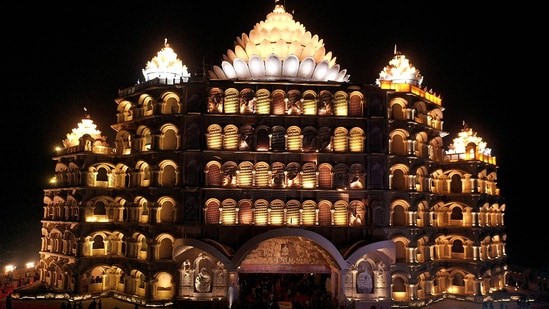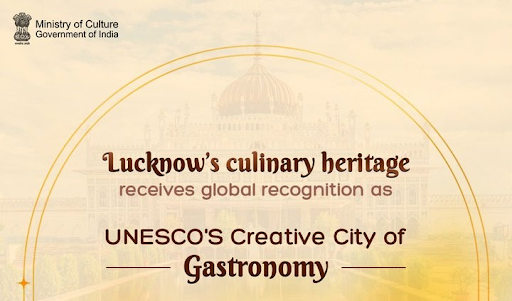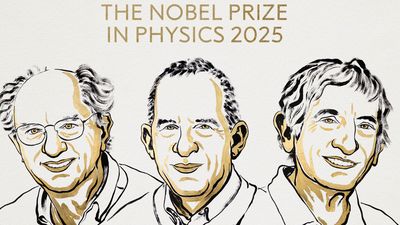Description

Disclaimer: Copyright infringement not intended.
Context
Prime Minister Narendra Modi inaugurated the Swarved Mahamandir, a magnificent seven-floor temple located in Varanasi's Umaraha area which is the world’s largest meditation centre.
Details
- The visit marked the centenary celebration of Vihangam Yoga and the establishment of Vihangam Yog Sansthan by Sadguru Sadafal Deoji Maharaj, a renowned 19th-century spiritual leader.
Architectural Marvels
- Design: The temple features an impressive design, including 125-petal lotus domes and can accommodate 20,000 individuals for meditation.
- Location: Situated in the Umaraha area, it covers an expansive area of 3,00,000 square feet, approximately 12 km from Varanasi's city center.
- Foundation and Construction: Laid in 2004, the temple's construction involved collaborative efforts from 600 workers and 15 engineers.
Distinctive Features
- Intricate Details: The temple boasts teakwood ceilings and doors adorned with intricate carvings, along with 101 fountains enhancing its aesthetic appeal.
- Spiritual Emphasis: Verses from the Swarveda, a spiritual text by Sadguru Shri Sadafal Deoji Maharaj, adorn the walls of the seven-floor superstructure.
- Materials and Garden: Pink sandstone embellishes the walls, and a medicinal herb garden adds to the temple's beauty.

Spiritual Significance
- Swarved Mahamandir: Named after the Swarveda, the temple aims to promote the teachings of this spiritual text.
- Purpose: It aims to radiate a spiritual aura, spreading a state of peaceful awareness worldwide.
- Teachings: The temple advocates Brahm Vidya from the Swarveda, promoting spiritual wisdom and unwavering peace.
- Teachings' Focus: Swarved Mahamandir focuses on propagating Brahm Vidya from the Swarveda, aiming to enlighten seekers spiritually.
- Worldwide Influence: The temple's vision is to illuminate humanity and inspire a state of serene consciousness globally.
Meditation in India
Historical Significance:
- Ancient Origins: The practice of meditation finds its origins in ancient Indian scriptures like the Vedas, Upanishads, and the Bhagavad Gita, dating back thousands of years.
- Vedic Period: Early references to meditative practices were primarily linked to Vedic rituals, focused on mental concentration and spiritual contemplation.
- Spiritual Heritage: Meditation flourished within the teachings of great spiritual leaders like Buddha, Mahavira, Adi Shankaracharya, and others.
Meditation Traditions:
- Yoga and Meditation: Yoga, a comprehensive system that includes physical postures (asanas), breath control (pranayama), and meditation, originated in India. Patanjali's Yoga Sutras, dating back to around 200 BCE, outline meditation practices as part of the eight-fold path to enlightenment.
- Vipassana and Mindfulness: The practice of Vipassana, popularized by Gautama Buddha, focuses on mindfulness and insight, observing sensations and thoughts to achieve self-awareness and liberation from suffering.
- Jain Meditation: Jainism emphasizes deep contemplation, focusing on self-realization, shedding karmic bondage, and achieving spiritual purity through meditation.
- Transcendental Meditation (TM): TM, introduced by Maharishi Mahesh Yogi in the mid-20th century, is a technique involving silent repetition of a mantra, aiming for inner peace and transcendence.
Influence on Culture and Society:
- Religious Practices: Meditation is integral to various religious practices in India, including Hinduism, Buddhism, Jainism, and Sikhism, forming a core aspect of spiritual rituals and daily routines.
- Ashrams and Spiritual Centers: Across India, numerous ashrams, monasteries, and spiritual centers serve as hubs for meditation retreats, teachings, and spiritual guidance.
- Cultural Integration: Meditation has transcended religious boundaries, becoming an integral part of India's cultural fabric, influencing art, literature, music, and traditional healing practices.

Conclusion
The Swarved Mahamandir, inspired by the Swarveda, stands as a testament to spiritual enlightenment and peacefulness. With its architectural brilliance and focus on propagating profound spiritual teachings, it strives to illuminate humankind with a divine spiritual aura, emphasizing inner peace and spiritual wisdom.
|
PRACTICE QUESTION
Q. Discuss the historical origins and evolution of meditation practices, highlighting their significance in various ancient civilizations. How have these practices shaped cultural, spiritual, and philosophical aspects across different societies? (250 Words)
|















